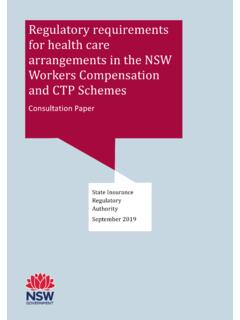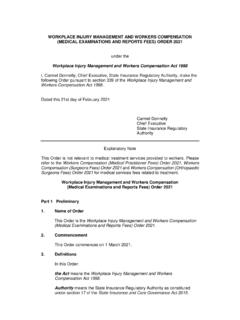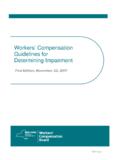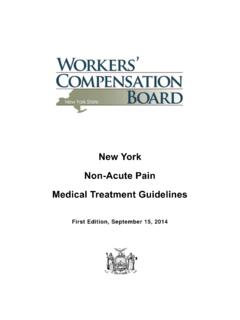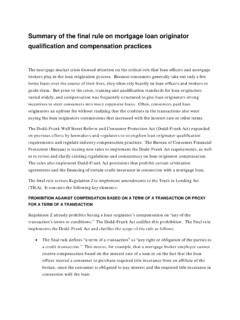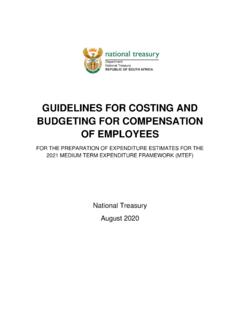Transcription of Workers compensation guidelines - Home - SIRA
1 Workers compensation guidelines Requirements for insurers, Workers , employers, and other stakeholders 1 March 2021 State Insurance Regulatory Authority 2 Table of Contents About these guidelines .. 4 Context .. 4 Legislative framework .. 4 Purpose .. 5 Guideline-making powers .. 5 Interpretation .. 5 Commencement .. 5 Exempt categories of Workers .. 5 .. 5 Part 1: Initial notification of an injury .. 7 Initial notification of 7 Part 2: Provisional liability .. 8 Delaying provisional weekly payments ..8 Provisional liability for medical expenses .. 9 Part 3 Making a 10 Minimum requirements for a claim .. 10 Requirement for a claim form.
2 10 Signed authority .. 10 Part 4: compensation for medical, hospital, and rehabilitation expenses .. 12 Accessing treatment without pre-approval .. 12 Determining reasonably necessary treatment .. 14 Qualifications and requirements for treatment or service providers .. 15 Domestic assistance care plan .. 15 Verifying gratuitous domestic assistance .. 16 Verifying and approving gratuitous domestic 16 Part 5: Work capacity Assessment .. 17 Work capacity assessment .. 17 When to conduct a work capacity assessment .. 17 Requirement to attend appointments .. 17 Part 6: Injury management consultants .. 19 IMC functions relating to the nominated treating doctor.
3 19 IMC functions relating to the worker .. 19 IMC functions relating to the employer .. 20 IMC functions relating to other service providers .. 20 IMC functions relating to the Personal Injury Commission .. 20 The IMC report .. 20 Part 7: Independent medical examinations and reports .. 22 Reason for referral .. 22 State Insurance Regulatory Authority 3 Qualified and appropriate independent medical examiners .. 22 Permanent impairment assessors .. 23 Conflict of interest .. 23 Special requirements .. 23 Notification to the worker .. 23 Further independent medical examinations .. 24 Unreasonable request .. 25 Part 8: Lump sum 26 Relevant particulars about a claim.
4 26 For injuries received on or after 1 January 2002 .. 26 For injuries received before 1 January 2002 .. 26 Complying agreements .. 26 Part 9: Commutation of compensation .. 27 compensation not to be commuted for catastrophic injuries .. 27 Spinal cord injury .. 27 Brain injury .. 27 Amputations .. 27 Burns .. 28 Permanent blindness .. 28 Part 10: Pre-injury average weekly earnings .. 29 Pre-injury average weekly earnings of apprentices, trainees and young people .. 29 Determining whether a benefit has been provided and whether the worker is entitled to use of the benefit .. 30 Monetary value of non-monetary 30 Residential accommodation not subject to fringe benefits tax.
5 31 State Insurance Regulatory Authority 4 About these guidelines The State Insurance Regulatory Authority (SIRA) is the government organisation responsible for regulating and administering Workers compensation , motor accidents compulsory third party (CTP) insurance and home building compensation insurance in New South Wales (NSW). Context Under section 23 of the State Insurance and Care Governance Act 2015, a principal objective of SIRA in exercising its functions is to provide for the effective supervision of claims handling and disputes arising under NSW Workers compensation legislation. The Workers compensation guidelines ( guidelines ) are supported by Standards of practice (Standards) which outline claims administration and conduct expectations for insurers.
6 SIRA s objective in developing the guidelines and Standards is to improve outcomes in the Workers compensation system by ensuring that clear, consistent, easy to access expectations are set for all insurers, to guide insurer conduct and claims management. It is important that injured Workers are protected and that they receive appropriate, timely, respectful services and support. Similarly, it is important that employers are actively engaged in the claims process to support Workers with their recovery and return to work. SIRA uses the guidelines and the Standards to hold insurers accountable for delivering high standards of service to Workers and their families, carers, employers and other stakeholders.
7 Legislative framework The Workers compensation Act 1987 (1987 Act), the Workplace Injury Management and Workers compensation Act 1998 (1998 Act), and the regulations made under those Acts establish a workplace injury management and Workers compensation system in New South Wales. The system objectives as described in section 3 of the 1998 Act are: to assist in securing the health, safety and welfare of Workers and, in particular, preventing work-related injury, to provide: prompt treatment of injuries, and effective and proactive management of injuries, and necessary medical and vocational rehabilitation following injuries, in order to assist injured Workers and to promote their return to work as soon as possible, to provide injured Workers and their dependants with income support during incapacity, payment for permanent impairment or death, and payment for reasonable treatment and other related expenses, to be fair, affordable, and financially viable, to ensure contributions by employers are commensurate with the risks faced, taking into account strategies and performance in injury prevention.
8 Injury management, and return to work, to deliver the above objectives efficiently and effectively. The Personal Injury Commission Act 2020 (PIC Act) establishes the Personal Injury Commission of New South Wales on 1 March 2021. The Personal Injury Commission is a single, independent tribunal and will replace the Workers compensation Commission and SIRAs Dispute Resolution Services that currently manage disputes involving injured State Insurance Regulatory Authority 5 Workers and road users on and from 1 March 2021. The PIC Act also establishes the Independent Review Officer (IRO). On and from 1 March 2021, the IRO replaces the Workers compensation Independent Review Officer (WIRO) and also assumes functions in the motor accident scheme.
9 The functions of the IRO are set out in Schedule 5 to the PIC Act. Purpose The Workers compensation guidelines ( guidelines ) support delivery of the objectives of the Acts and Regulation by informing and guiding insurers, Workers , employers, injury management consultants, independent medical examiners and other stakeholders in the process of claiming Workers compensation in NSW. Guideline-making powers These guidelines are made under section 376(1)(c) of the 1998 Act, which empowers SIRA to issue guidelines in accordance with specific guideline-making powers throughout the Workers compensation Acts. Each Part of these guidelines identifies the section or sections of the Acts that authorise or require guidelines to be issued by SIRA.
10 SIRA requires stakeholders to comply with the parts of the guidelines that apply to them. Interpretation These guidelines are to be read in conjunction with relevant provisions of the Acts and the Regulation and in a manner that supports the system objectives as described in section 3 of the 1998 Act. Commencement These guidelines will take effect and apply to all claims from 1 March 2021 (irrespective of when the claim is made). Part 10 of these guidelines , pre-injury average weekly earnings, applies only to Workers injured on or after 21 October 2019. The guidelines will apply until SIRA amends, revokes or replaces them in whole or in part. These guidelines replace the Workers compensation guidelines dated 17 April 2020.



